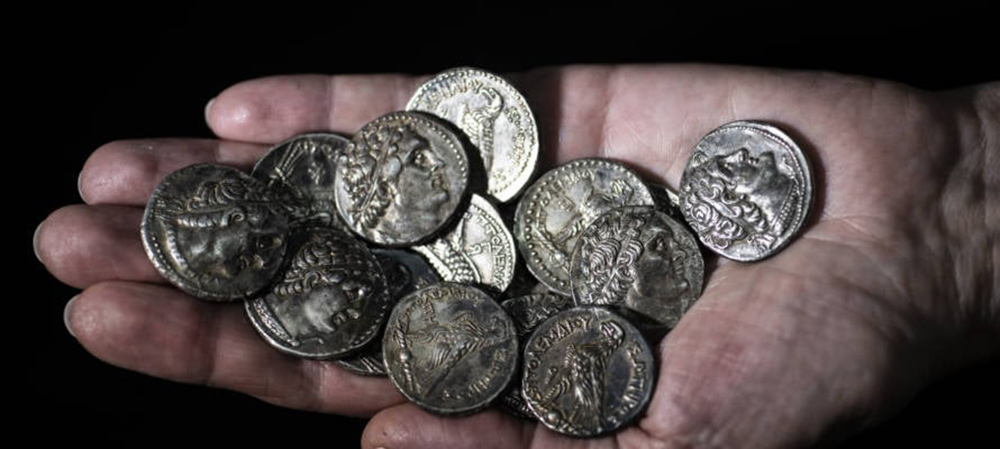Israeli archaeologists discovered the first evidence of the Maccabean Revolt against the Greek Seleucid Kingdom in the Judean Desert.
By: United with Israel Staff
This week, the Israel Antiquities Authority (IAA) announced a momentous new find: a wooden box containing 15 silver coins dating to the time of the Jewish revolts against Greek invaders around 2,200 years ago.
The coins were identified as belonging to the period of Antiochos IV’s reign. They were discovered at an excavation site in the Darageh Stream Nature Reserve, near the Dead Sea.
According to an IAA statement, the coins were “dated to the days leading up to the Maccabean Revolt” and the “wooden box was probably hidden in the cave by an individual fleeing the fighting” who intended “to return to collect his money after the revolt”
The coins will be exhibited in the Hasmonean Museum in Modi‘in during “Israel Heritage Week” timed to coincide with will the Chanukah holiday, which takes place December 18-26 this year.
“Among the many finds, the unique lathe-turned wooden box was discovered in a crack in the cave,” continued the IAA statement. “When the lid was removed, it turned out that the upper part of the box was full of packed earth and small stones. Below this earth layer, a large piece of purple woolen cloth was found, covering the 15 silver coins that were arranged with pieces of sheep’s wool in the lower part of the box.”
The IAA continued, “The coin hoard, cleaned in the Israel Antiquities Authority metal finds laboratory, comprised a homogeneous group of silver tetradrachma coins, minted by Ptolemy VI, King of Egypt. Ptolemy VI reigned over Egypt at the same time as his uncle Antiochos IV Epiphanes (‘the Wicked’) reigned over the Seleucid Kingdom, including Judea. The three earliest coins in the hoard were minted in 176/5 BCE, and the latest coin dated to 171/0 BCE. The name ‘Shalmai’ in Aramaic script was found secondarily incised on one of the coins.”
The IAA fixed the year the hoard was hidden as around 170 BCE based on the date of the latest coin in the hoard, which was the beginning of the Maccabean Revolt and the war that Antiochos Epiphanes IV declared on the Jewish religion.
The IAA’s Director Eli Escusido added, “The coin hoard that will be exhibited to the public in the framework of the Israel Heritage Week events fires the imagination and connects us with “those days in this season. This is the Chanukah ‘gelt’ (money) that the Israel Antiquities Authority is donating to the people and the State of Israel. I invite the public to take part in the excavations in the Wadi Muraba‘at cave in December. We consider that the cave has not yet said its final word!”
In October, JNS reported that an Israeli scientific breakthrough has enabled researchers to verify biblical accounts of wars between ancient Jewish kingdoms and their enemies, according to a statement released by Tel Aviv University.
The scientists examined archaeological findings containing magnetic minerals which, when heated or burned, record the local magnetic field. These magnetic records can thus be used to date the fires, matching them to reported military campaigns, in a manner reminiscent of radiocarbon dating, according to the JNS report.
Using such records, a joint study by TAU and the Hebrew University of Jerusalem, employing some 20 researchers from a variety of countries and disciplines, was able to accurately date destruction layers at 17 archeological sites throughout Israel, according to the statement.
(United with Israel & JNS)





